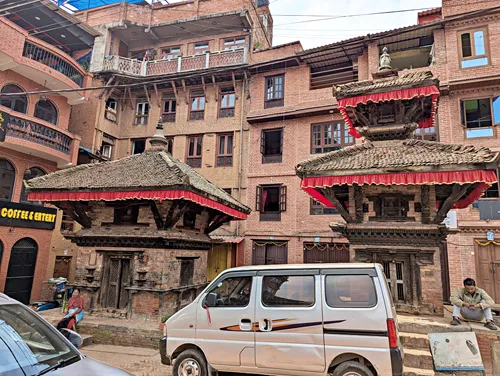Uma Maheshwar & Anantalingeswar Temples: Your Guide to Bhaktapur's Sacred Sites - Nepal Purple Travel Guide
(map, reviews)
This is Premium Content! To access it, please download our
Backpack and Snorkel Purple Travel GuideLocated a few feet to the west of Bhaktapur Durbar Square, stand two shrines. The taller of the two is Uma Maheshwar Temple, and the smaller shrine is Anantalingeswar Temple.

Here at Backpack and Snorkel Travel Guides, we typically promote self-guided walking tours.
But we realize that not everybody likes to walk by themselves in a foreign city. So, just in case that you rather go with ab guide: NO PROBLEM! Please see the Viator tours below.
free GuruWalk tours
paid Viator tours
What is Uma Maheshwar Temple?
Dedicated to the divine couple Uma (Parvati) and Maheshwar (Shiva), this temple reflects the timeless harmony between the masculine and feminine forces of the universe - making it a meaningful stop for spiritual seekers and culture lovers alike.
The Origin of the Name Uma Maheshwar Temple
The name Uma Maheshwar comes from Hindu mythology:
Uma is another name for Parvati, the benevolent goddess of love, devotion, and fertility.
Maheshwar is one of the many names for Shiva, the god of transformation and cosmic power.
Together, Uma and Maheshwar represent the divine union of energy and consciousness, embodying balance in the cosmos and in human life.
Architecture and Atmosphere of Uma Maheshwar Temple
The Uma Maheshwar Temple in Bhaktapur features traditional Newar architecture, with a multi-tiered pagoda roof, intricately carved wooden struts, and a stone platform that elevates it above the surrounding square. Statues of the divine couple can be seen seated together inside the shrine.
What is Anantalingeswar Temple?
Anantalingeswar Temple is dedicated to Lord Shiva, one of the principal deities in Hinduism. Unlike the towering pagodas of central Bhaktapur, this temple is modest in size but deeply revered by locals. Its stone linga (a symbolic representation of Shiva) is said to be ancient, and the site has long been a place of prayer, meditation, and ritual offerings.
The Origin of the Name Anantalingeswar Temple
The name Anantalingeswar is rooted in Sanskrit. ‘Ananta’ means eternal or infinite, and ’Lingeswar’ refers to Lord Shiva in his symbolic form, the linga (typically a cylindrical or elliptical pillar-like structure, often placed on a circular base called a yoni, which represents the goddess Shakti). Together, the name means ‘Lord Shiva of Infinite Forms’, emphasizing Shiva’s role as the timeless, formless cosmic force in Hindu philosophy.
Architecture of Anantalingeswar Temple
The temple is built in traditional Newar architectural style, including a low roof and beautifully carved wooden struts.
Legend about how Anantalingeswar Temple was founded
There is another Anantalingeswar Temple south of Bhaktapur, in Suryabinayak, which is considered the original Anantalingeswar Temple. The temple that you are looking at can be seen as a royal (Malla) or urban homage to the original Suryabinayak temple.
There is an interesting legend on how the original Anantalingeswar Temple was founded:
According to locals, centuries ago, a group of great sages performed penance (act of self-punishment or religious devotion performed to show sorrow or repentance for sins or wrongdoing) in the forest that once covered this area. One day, overcome with thirst, they went searching for water and reached the edge of a nearby hill. Not finding any water on the surface, they began digging into the ground.
To their surprise, they unearthed a Shivalinga (symbolic representation of the Hindu deity Shiva). Even after digging down 30 feet, they could not find its base. Instead of water, blood began to ooze from the ground. This miraculous event led to the belief that the linga is Ananta (eternal and limitless) and thus, it came to be worshiped as Anantalingeswar, meaning ‘Lord Shiva in his infinite form’.
The sages later dug another well nearby. This well produced sweet water, which locals believe has healing properties and can cure diseases. According to oral tradition, Rana Prime Minister Chandra Shamsher is said to have had water fetched from this well regularly.
Back to your self-guided tour
Author: Rudy at Backpack and Snorkel
Bio: Owner of Backpack and Snorkel Travel Guides. We create in-depth guides to help you plan unforgettable vacations around the world.
Other popular Purple Travel Guides you may be interested in:
Like this Backpack and Snorkel Purple Travel Guide? Pin these for later:





